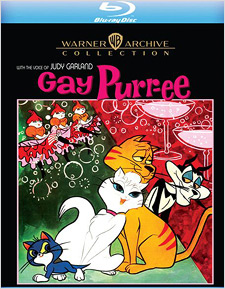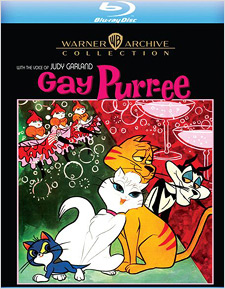Gay Purr-ee (Blu-ray Review)

Director
Abe LevitowRelease Date(s)
1962 (August 29, 2023)Studio(s)
United Productions of America/Warner Bros. (Warner Archive Collection)- Film/Program Grade: C+
- Video Grade: A
- Audio Grade: B+
- Extras Grade: B-
Review
Feature animation was dominated by Walt Disney since 1937’s Snow White and the Seven Dwarfs. The company turned out one successful animated film after another, usually with strong storylines. In 1941, following an acrimonious strike against Disney, former animators for the company founded UPA (United Productions of America). Gay Purr-ee, released in 1962, was UPA’s second and final foray into the realm of feature animation.
The setting is the turn of the nineteenth century, also known as the Gay Nineties. Narrator Morey Amsterdam, with a stereotypical French accent, sets the scene and tells us that we’re about to witness one of the great French love stories. On a farm in Provence live three cats. Mewsette (voice of Judy Garland) is a white Angora house cat. Jaune Tom (Robert Goulet) is a yellow tabby who prides himself on being a mouser extraordinaire. Robespierre (Red Buttons) is Jaune Tom’s kitten sidekick.
The slim plot flows from Mewsette’s longing to go to Paris, since she’s heard what a wonderful, sophisticated place it is. She makes it to the City of Lights. Jaune Tom and Robespierre follow but not in time to prevent Mewsette from falling in with con artist cat Meowrice (Paul Frees). The sweet-talking Meowrice entices Mewsette to board with Madame Rubens-Chatte (Hermione Gingold), a massive pink Persian, who will teach her how to reach her peak potential. Meowrice and Rubens-Chatte are partners in running a sordid crime ring. Their plan is to sell Mewsette to a rich American cat. To avoid interference from Jaune Tom and Robespierre, Meowrice has them shanghaied onto a ship headed toward Alaska.
The screenplay by Dorothy and Chuck Jones is not terribly substantial and deals with some questionable material, such as the attempt to sell Mewsette for profit. Though the word “prostitution” is never uttered, it’s clear what Meowrice’s intentions are. For a film targeted, I assume, to children, this major plot point seems in questionable taste.
Chuck Jones’ cartoon shorts for Warner Bros. are filled with gags and move briskly. In Gay Purr-ee, the plot is poorly motivated, the story is drawn out, the characters are bland, and there’s little humor. Though derivative of other films, specifically Pinocchio, Lady and the Tramp, and Gigi, the magic never happens.
UPA animation is more stylistic than Disney animation. Bright, colorful backgrounds and impressions of objects take the place of realistic renderings. They incorporate a minimalist style. The characters move through the technique of limited animation, in which movement isn’t smoothly continuous. This technique was adopted later in the decade for children’s cartoon shows on TV, mostly to save money.
Only one sequence stands out. Meowrice shows Mewsette’s purchaser how she would be painted in the styles of Monet, Toulouse-Lautrec, Seurat, Rousseau, Modigliani, Van Gogh, Degas, Renoir, Crezanne, Gauguin and Picasso—a clever art history course in a few minutes.
The film contains songs by Harold Arlen and E.Y. Harburg, who wrote the memorable tunes for The Wizard of Oz. They include Little Drops of Rain, Roses Red, Violets Blue, and Paris Is a Lonely Town. Most are sung by Judy Garland, who’s in excellent voice. She also sings a medley of the film’s songs under the title credits. Robert Goulet solos on Mewsette and duets with Red Buttons on Bubbles. Paul Frees, as Meowrice, sings The Horse Won’t Talk. The songs are pleasant but don’t come near the quality of Arlen and Harburg’s music and lyrics for Oz. Garland, of course, makes the songs sound wonderful, but they are definitely not the composers’ finest.
Gay Purr-ee was produced using traditional hand-drawn animation and presented on 35 mm film in the theatrical aspect ratio of 1.85:1. The Blu-ray is sourced from a new 4K scan of the film’s original camera negative. The color palette really pops, starting with the vibrant titles and continuing throughout. Bold reds, sunshine yellows, bright blues, and radiant greens seem to make many scenes come alive. Zooms are used frequently to move from a wide shot to a medium shot, in order to make use of the space afforded a rectangular, widescreen image. Meowrice’s gang of cats are rendered minimally, with large heads and piercing yellow eyes, so that when bunched together, they look like a multi-headed, multi-limbed monster. Backgrounds are extremely stylized and rich in color.
The soundtrack is English 2.0 Mono DTS-HD Master Audio. Optional English SDH subtitles are available. The French accents vary from tolerable to terrible, with little consistency among characters. The songs are beautifully recorded and are enhanced by the big sound of a studio orchestra. Incidental music by Mort Lindsey provides a sprightly feel to the proceedings. Garland’s singing voice is filled with emotion, but her speaking voice is flat and not terribly interesting. Hermione Gingold’s distinctive voice is the best feature of Madame Rubens-Chatte and Paul Frees adds the proper balance of menace and con artistry to his vocal characterization of Meowrice.
Bonus materials on the Blu-ray release from Warner Archive include the following:
- Louvre Come Back to Me (Cartoon) (6:40)
- French Rarebit (Cartoon) (7:18)
- For Scent-imental Reasons (Cartoon) (6:54)
- Demo Recordings:
- Little Drops of Rain – Harold Arlen (2:39)
- Roses Red, Violets Blue – Harold Arlen, E.Y. Harburg (1:41)
- The Horse Won’t Talk – Harold Arlen (3:43)
- The Money Cat – Harold Arlen, E.Y. Harburg (2:07)
- Paris Is a Lonely Town – Harold Arlen (2:46)
- Original Theatrical Trailer (3:44)
Louvre Come Back to Me – Pepe Le Pew stars in this 1962 Warner Bros. Looney Tunes cartoon directed by Chuck Jones. Pepe is in Paris, where his odor sends a female cat upward to hit a freshly painted flagpole, which puts a white stripe on her back and causes Pepe to think she’s a girl skunk. He pursues her into the Louvre art gallery, where his foul scent causes the images in several paintings to change poses in disgust. The female cat’s feline lover has followed them into the Louvre and challenges Pepe to a duel. Mel Blanc provides the cartoon voices.
French Rarebit – This 1951 Warner Bros. Merrie Melodies cartoon directed by Robert McKimson stars Bugs Bunny. In Paris, Louis and Francois, chefs of rival restaurants, argue over which establishment will have Bugs on the dinner menu. Once again, Mel Blanc contributes his vocal talents.
For Scent-imental Reasons – In this 1949 Warner Bros. Merrie Melodies cartoon directed by Chuck Jones, Pepe Le Pew chases a female cat in a perfume shop until she turns the tables on him. Mel Blanc provides his vocal magic.
Garland’s voice is the star of Gay Purr-ee. This was the first time a major star was used in a feature animated film. Unfortunately, the material doesn’t live up to her vocals. With its threadbare plot, a minimum of humor, and little suspense, Gay Purr-ee fails to engage the viewer with memorable characters and lacks sparkle.
- Dennis Seuling

